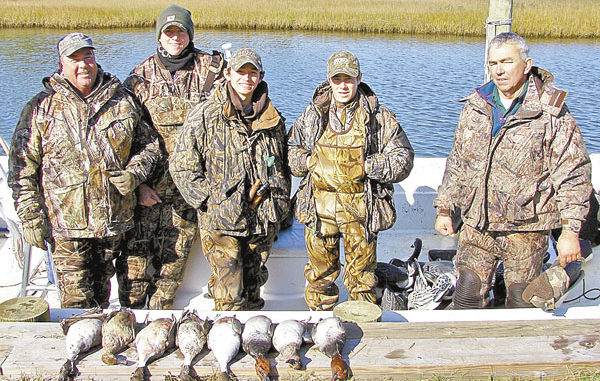
Sight unseen, hunters in curtain blinds can give ducks and brant a steel-shot sandwich.
The distant flock of ducks pulsed in the early morning light, swinging wide towards Hatteras. They made the turn and let the hunters know they had seen the spread of decoys in the shallow water several miles out in Pamlico Sound. The flock’s shape changed from wide to long as the ducks fell into a loose group headed across the edge of the sound and toward the waiting hunters.
Watching the ducks shift their formation, Rom Whitaker IV — “Little Rom” — tensed in the blind.
“Pintails. With this wind, they’ll probably shift a little to our right before coming in,” he said. “Keep your head down and your face hidden and we should get our pintails first thing this morning. They’ve shifted and will be coming in from about 2 o’clock. Try and pick out the drakes. They’ll be the ones with the longer tails.”
The next 30 seconds seemed more like 30 minutes, but finally, Whitaker called the shot. As soon as the hunters moved, the ducks flared and flapped frantically to gain elevation and get out of shotgun range. Unfortunately for the ducks, that move gave the hunters easy shots. Whitaker cleanly folded a pair of sprigs, while an excited friend managed to hit and then miss, and it took his third shot to bring down his second duck.
Thinking they heard congratulatory shouting from a neighboring blind that housed Whitaker’s father, Rom III, and brother, Cameron, the two hunters turned just in time to see a lone bird winging in.
“Load up quick,” Whitaker said in a hoarse half-whisper “That’s a brant.”
Shoving two shells into his shotgun, Whitaker said, “Look at that goofy wing beat. Brant aren’t hard to spot. They move different than any other ducks or geese, and when they are in flocks, it’s even easier to notice.”
The brant continued in, and at about 15 yards, Whitaker called the shot. The bird flared at the hunters’ movement, but being bigger, the move wasn’t as fast. The result was the same too, as a 3½-inch load of No. 3 steel shot caught up to it and sent it tumbling to the water.
“I better get out here and pick up these birds before they drift away and get too deep,” Whitaker said. “That’s pretty good. It’s just getting to the time when the ducks usually fly out here in the sound, and we’ve got limits of pintails and a brant. I expect Dad and Cameron are going to want to trade out for a while and see if they can get their pintails before the sun gets too high.”
As he waded through the decoys toward for the floating ducks, a skiff with a jet outboard came zipping along from the large blind about 500 yards to the east. The water between the blinds wasn’t more than inseam deep anywhere, but the skiff got to the birds much faster than the wading hunter. The elder Whitaker, who runs the Release, a Hatteras-based charterboat, sped out to pick up the most-distant ducks and save “Little Rom” a bunch of steps. He returned with two pintails and the brant as they pulled up to the edge of the decoys.
“That was pretty good shooting,” said the senior Whitaker. “If the pintails are going to fly early, how about let’s switch places for a while and let Cameron and I see if we can get ours? After that, we’ll switch again for redheads or whatever might fly later. Cameron just finished making y’all some egg and bacon sandwiches and they are wrapped in foil on the stove in the big blind.”
The decoys around the smaller blind had been set meticulously. The puddlers were positioned downwind, off the corner of the blind, and the divers were upwind and off to the left. Canada goose decoys sat on the wing and at the corners of the blind, and a few floating brant decoys were out in front. However, as natural as the decoy spread appeared, that was only part of what was convincing the ducks to come in.
Sealing the deal was that the ducks couldn’t see the blind and hunters. Rom Whitaker III had taken the time to get a permit to install a curtain blind on Hatteras Reef, a shoal several miles out in Pamlico Sound behind Hatteras. Ducks and brant feed on the grass that grows in the shallow water, and the curtain blind allowed the hunters to hide, mostly below water level, right in the middle of the decoy spread. Ducks and brant don’t see the hunters, so they come right in.
One of the special things about waterfowl hunting at Hatteras is the Atlantic brant. The Outer Banks is as far south as the small, saltwater geese roam. The elder Whitaker said the brant that winter at Hatteras work their way down the Atlantic coast from breeding grounds above the Arctic Circle. Their last stop before the Outer Banks is in the Chesapeake Bay.
Whitaker said brant are generally tasty, but sometimes can be bitter when they first arrive at Hatteras. He said that after living here a few weeks, whatever they ate in the Chesapeake Bay that made them bitter works through their system, and they taste good again. That’s local knowledge put to good use.
Unlike many waterfowl hunts that end shortly after sunrise, this one was just beginning. As the sun rose skyward, the diving ducks began flying. They traded back and forth across the protected water between the shoal and Hatteras Island, with flocks of redheads keeping the hunters busy and entertained. Small ducks, mostly buffleheads, traded back and forth constantly, but weren’t harassed. A couple of flocks of bluebills were a pleasant surprise, and a small flock of swans rested nearby for while.
With the good shooting, calls were made that evening, and friends were invited for a hunt the next morning. While he charter fishes as a business, Whitaker hunts ducks for his personal relaxation and is very good at both. Those friends who are lucky enough to receive an invitation to duck hunt usually leave smiling as broadly as his charter customers on the Release.

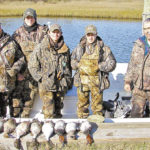
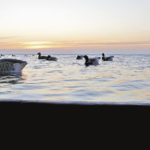
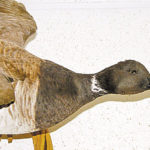
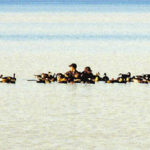
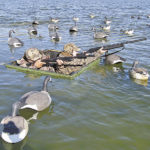
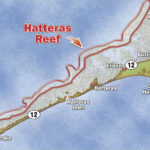



Be the first to comment